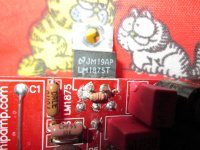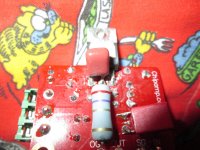Building an amp for stereo speakers. Wattage is unmarked, but they run well with a 10W amp, and I guess impedance is around 6-8 Ohm
Power Amplifier
There's a list of amps there: TDA2030, LM3886.
I don't mind building a circuit board from sscrath, soldering and stuff.
So basically: What is the main difference between LM3886, LM1875, LM3875, LM386(small amp projects -2W?), TDA2030, TDA2030A+ (Lepai amp) ?
What would be the best and easiest to build. Lepai amps on Amazon.in go for around 2-3k (rupees).
Power Amplifier
There's a list of amps there: TDA2030, LM3886.
I don't mind building a circuit board from sscrath, soldering and stuff.
So basically: What is the main difference between LM3886, LM1875, LM3875, LM386(small amp projects -2W?), TDA2030, TDA2030A+ (Lepai amp) ?
What would be the best and easiest to build. Lepai amps on Amazon.in go for around 2-3k (rupees).
I'd like to add the prices for individual IC's:
LM1875T -Rs.145
LM3875TF - Rs.372
LM3886T - 380
LM3886T 380
I jst checked.. theres something about the TF versions needing a huge heatsink and something about insulation. What would you recommend?
LM1875T -Rs.145
LM3875TF - Rs.372
LM3886T - 380
LM3886T 380
I jst checked.. theres something about the TF versions needing a huge heatsink and something about insulation. What would you recommend?
If these are Indian Rs., the price seems to be high by a factor of 2x. If you can get authentic NOS ST TDA2050, I'd recommend it as the best value around. Even if you blow up a few, it isn't going to burn a huge hole in your pocket.
Okay, but of these, which is the best? LM3886?
It depends on the application - there are some who swear by the LM1875, and others who prefer the LM3875. In my case, I've not heard anything better than the TDA2050 in the MiniRef v1.04 (which can also use the LM1875).
If you want to use the LM3886, the best designs that use it are the MyRef (various) and the Modulus-86.
Here's a pic of a MyRef-X2 prototype, designed for 80W into 4 ohms with 2x LM3886TF:
http://www.diyaudio.com/forums/chip-amps/264278-lm3875-composite-amp-4.html#post4114819
Okay, do between the TDA2050 (which is a high power TDA2030), and the LM3886, what would be the main features/ deciding factors? Difficulty, External components, Quality etc?It depends on the application - there are some who swear by the LM1875, and others who prefer the LM3875. In my case, I've not heard anything better than the TDA2050 in the MiniRef v1.04 (which can also use the LM1875).
If you want to use the LM3886, the best designs that use it are the MyRef (various) and the Modulus-86.
Here's a pic of a MyRef-X2 prototype, designed for 80W into 4 ohms with 2x LM3886TF:
http://www.diyaudio.com/forums/chip-amps/264278-lm3875-composite-amp-4.html#post4114819
Will there be any considerable difference between the LM and TDA?
Btw, LM3886 and LM1875.. ??
.
I know it's not what you want to hear, but none of them are best. All will give you excellent audio quality.
However, the LM1875 does have two things going for it. First is the low parts count and simple wiring. If you're just starting out building audio amps this is significant.
Second is the fact that some believe the LM1875 has a superior "musical quality." Of course this is debatable, and many people can't hear any difference at all, but...well, that's what they say.
You've listed chips with different power outputs, and output power could be your deciding factor. Remember that amplifiers don't produce sound, speakers produce sound. The real question is always "which amp will drive my speakers?"
At normal listening levels only about 1 watt of sound actually reaches our ears, 5 watts is very loud, more might cause hearing damage. The bottom line here is that for normal living room listening something like a 20-watt LM1875 amp is more than enough. Around 20 watts is more or less the classic living room setup.
But if you have large multiple speakers, or a large listening area, then something like a 50-watt LM3886 (also low parts count and simple wiring) will serve you better. In a sidebar, note that doubling output watts does not double sound levels, the watts/sound-level progression is logarithmic. But again the question is not how many watts, the question is driving the speakers.
Different but related matters are the heat sink for the audio chip, and the size of the power supply. Decide on a heat sink early on because this takes up a lot of space and has to be mounted somehow. Tip: the heat sinks sold for use with computer CPUs (Central Processing Units) are effective, they can be used with or without the fan that comes with them. Using the fan allows a smaller heat sink. Look for "heat sinks" on eBay.
In a way the power supply requires more attention than which audio chip to use. Not that power supplies are complicated (they're not), but the important rule here is: do not stint.
Next to the housing the power transformer is the most expensive part of any audio amp, but you just have to spend the money. For a 20-watt amp a 30-watt power transformer is minimal. For a 50-watt amp use at least a 75-watt transformer. More is better. This is simply because audio chips are not efficient, they waste a lot of power in the form of heat, and that power has to come from the power supply.
Just to mention it, I personally see no advantage to using expensive toroid power transformers. Others differ.
PS: None of which is to argue with linuxguru's observations on the TDA2050. As before, sad but true, there is no best. But the upside of "no best" is that you can't lose.
.
I know it's not what you want to hear, but none of them are best. All will give you excellent audio quality.
However, the LM1875 does have two things going for it. First is the low parts count and simple wiring. If you're just starting out building audio amps this is significant.
Second is the fact that some believe the LM1875 has a superior "musical quality." Of course this is debatable, and many people can't hear any difference at all, but...well, that's what they say.
You've listed chips with different power outputs, and output power could be your deciding factor. Remember that amplifiers don't produce sound, speakers produce sound. The real question is always "which amp will drive my speakers?"
At normal listening levels only about 1 watt of sound actually reaches our ears, 5 watts is very loud, more might cause hearing damage. The bottom line here is that for normal living room listening something like a 20-watt LM1875 amp is more than enough. Around 20 watts is more or less the classic living room setup.
But if you have large multiple speakers, or a large listening area, then something like a 50-watt LM3886 (also low parts count and simple wiring) will serve you better. In a sidebar, note that doubling output watts does not double sound levels, the watts/sound-level progression is logarithmic. But again the question is not how many watts, the question is driving the speakers.
Different but related matters are the heat sink for the audio chip, and the size of the power supply. Decide on a heat sink early on because this takes up a lot of space and has to be mounted somehow. Tip: the heat sinks sold for use with computer CPUs (Central Processing Units) are effective, they can be used with or without the fan that comes with them. Using the fan allows a smaller heat sink. Look for "heat sinks" on eBay.
In a way the power supply requires more attention than which audio chip to use. Not that power supplies are complicated (they're not), but the important rule here is: do not stint.
Next to the housing the power transformer is the most expensive part of any audio amp, but you just have to spend the money. For a 20-watt amp a 30-watt power transformer is minimal. For a 50-watt amp use at least a 75-watt transformer. More is better. This is simply because audio chips are not efficient, they waste a lot of power in the form of heat, and that power has to come from the power supply.
Just to mention it, I personally see no advantage to using expensive toroid power transformers. Others differ.
PS: None of which is to argue with linuxguru's observations on the TDA2050. As before, sad but true, there is no best. But the upside of "no best" is that you can't lose.
.
Last edited:
I'd build from scratch and learn. The LM3886 is designed higher power use, 60+ watts. I'd start on something a bit easier (although the 3886 is no big deal in difficulty). If you want to build an amp in the 10-25w range, go for the LM1875. The TDA parts are good, but since ST Micro discontinued them over a year ago so getting authentic parts can be an issue. Here in the US, when the TDA2050 was discontinued. Stocks at Mouser and DigiKey went from over a thousand to 0 in a short time.
Thanks for all the replies!
I'll be using heatsinks extracted for an old PC ATX power supply, it already have screw holes drilled in it.
So basically, I should start with the LM1875 x2 (for stereo) right?
I'll be using heatsinks extracted for an old PC ATX power supply, it already have screw holes drilled in it.
So basically, I should start with the LM1875 x2 (for stereo) right?
These Overture power opamps (that's what they are really) are known to heat up beyond what those ATX power supply heatsinks can deal with. But if you also place them in the power supply case and use the readily available cooler you might do well.
About your original question, the IC's you mentioned have little to do with each other, other than all of them sound their best at a certain output power range, not maximum not minimum either.
LM386 makes a great headphone amplifier, it likes the relatively high impedance of headphones but sounds uninteresting and undetailed in my opinion when used with actual speakers. (you know the "pocket radio sound")
TDA2030 is easy to use and stable and i lovingly used those and their larger brothers 2040 for many years and they sounded amazing to me, until i came across the LM3886. I could never go back to those smaller chipamps.
The rest i haven't tested yet, but if i can draw a conclusion is maybe the perceived audio experience has to do with amplifier power capability to a great extent. The more headroom it has, the more potential it has to sound great with a wider range of speakers. But that's not the only concern, for instance i like the LM3886 a lot more than TDA7294. There are less stability concerns with the TDA so it's user friendly but just doesn't sound as perfect. But if i continue along these lines i could go on forever so i should just stop typing.
About your original question, the IC's you mentioned have little to do with each other, other than all of them sound their best at a certain output power range, not maximum not minimum either.
LM386 makes a great headphone amplifier, it likes the relatively high impedance of headphones but sounds uninteresting and undetailed in my opinion when used with actual speakers. (you know the "pocket radio sound")
TDA2030 is easy to use and stable and i lovingly used those and their larger brothers 2040 for many years and they sounded amazing to me, until i came across the LM3886. I could never go back to those smaller chipamps.
The rest i haven't tested yet, but if i can draw a conclusion is maybe the perceived audio experience has to do with amplifier power capability to a great extent. The more headroom it has, the more potential it has to sound great with a wider range of speakers. But that's not the only concern, for instance i like the LM3886 a lot more than TDA7294. There are less stability concerns with the TDA so it's user friendly but just doesn't sound as perfect. But if i continue along these lines i could go on forever so i should just stop typing.
.
<< So basically, I should start with the LM1875 x2 (for stereo) right? >>
My vote is yes. Which immediately starts another debate.
In my opinion you can't go wrong with the factory's "Typical Applications" circuit on page 2 of the data sheet, which is here: http://www.ti.com/lit/gpn/lm1875
My argument is that these chips are not created in a vacuum, related to nothing. The chip and the circuit it works in are developed at the same time by the same team of engineers, at a cost to the factory of tens of thousands of dollars. All of which should tell us that the given circuit is bulletproof, it cannot fail to give the excellent audio results guaranteed by the factory.
But others say no, the factory's circuit needs changes. They say they can design a better circuit, and...who am I to claim otherwise? The debate rages into eternity.
I personally am willing to say that speakers and their enclosures have far more effect on perceived audio quality than minor circuit changes ever could. After all, the chips we use today give accurate reproduction to two or three decimals or better, but speakers haven't quite caught up.
.
<< So basically, I should start with the LM1875 x2 (for stereo) right? >>
My vote is yes. Which immediately starts another debate.
In my opinion you can't go wrong with the factory's "Typical Applications" circuit on page 2 of the data sheet, which is here: http://www.ti.com/lit/gpn/lm1875
My argument is that these chips are not created in a vacuum, related to nothing. The chip and the circuit it works in are developed at the same time by the same team of engineers, at a cost to the factory of tens of thousands of dollars. All of which should tell us that the given circuit is bulletproof, it cannot fail to give the excellent audio results guaranteed by the factory.
But others say no, the factory's circuit needs changes. They say they can design a better circuit, and...who am I to claim otherwise? The debate rages into eternity.
I personally am willing to say that speakers and their enclosures have far more effect on perceived audio quality than minor circuit changes ever could. After all, the chips we use today give accurate reproduction to two or three decimals or better, but speakers haven't quite caught up.
.
I'm going to go with 1875
1) It has a different 'clipping' system than the SPIKE of the 3875/6, 3886, etc... Those in the know could say more...
2) It has more overall distortion than the others but it's flat over most of the audio range.
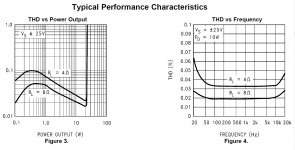
Vs the 3886, etc..., which has rising distortion over the audio range.
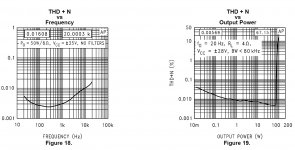
3) And given Tom's recent work with the 3886, we know how important it is to get the fb res close to the chip, with 1875 that's way easier. (especially if you get radical and put it right on the pins!, or shorten the pins ...)
And even with no fancy mute, the 1875 doesn't seem to generate much turn on/off pops/noise.
The FULL schematic!
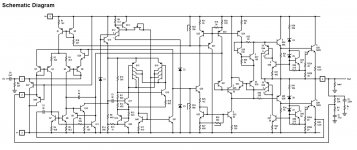
I really like it!
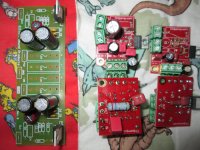
In fact, you've inspired me to make some more! Hmmmm, where's that transformer ...
1) It has a different 'clipping' system than the SPIKE of the 3875/6, 3886, etc... Those in the know could say more...
2) It has more overall distortion than the others but it's flat over most of the audio range.

Vs the 3886, etc..., which has rising distortion over the audio range.

3) And given Tom's recent work with the 3886, we know how important it is to get the fb res close to the chip, with 1875 that's way easier. (especially if you get radical and put it right on the pins!, or shorten the pins ...)
And even with no fancy mute, the 1875 doesn't seem to generate much turn on/off pops/noise.
The FULL schematic!

I really like it!

In fact, you've inspired me to make some more! Hmmmm, where's that transformer ...
Last edited:
Thanks for all the replies. I think I have decided on the LM1875 (x2)!
I agree, very minor differences in circuits cannot possibly make up for a good enclosure. Simply opening up the speaker cabinet changes the sound a lot.
I'll probably use the ATX heatsinks in the beginning, see how they deal with the heat, and then add a fan(I love cooling solutions, fans, heatsinks etc. )
I agree, very minor differences in circuits cannot possibly make up for a good enclosure. Simply opening up the speaker cabinet changes the sound a lot.
I'll probably use the ATX heatsinks in the beginning, see how they deal with the heat, and then add a fan(I love cooling solutions, fans, heatsinks etc. )
...
I agree, very minor differences in circuits cannot possibly make up for a good enclosure. Simply opening up the speaker cabinet changes the sound a lot.
Hun? you should have a gnd enclosure for shielding ... And major changes to the sound come from inv vs non-inv, extra pieces vs gainclone, etc ...
...
I'll probably use the ATX heatsinks in the beginning, see how they deal with the heat, and then add a fan(I love cooling solutions, fans, heatsinks etc. )
1875 run pretty warm at idle, (the ATX sinks themselves should be good enough (unless u r rockin'))
go full schem first (all the xtras), then ...
Last edited:
Easiest to build is far and away TDA8566 - power is a bit lower than the others but you probably don't need more (around 20W @ 18V supply into 8R, more into lower impedance loads). Single chip for stereo, bridged outputs mean half the number of supply caps.
Hmmmm...

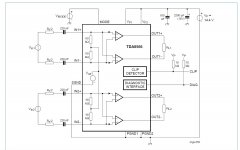
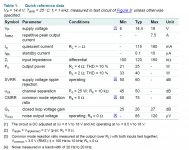
View attachment TDA8566.pdf
tell me more!
PS common mode cancellation with the inherent balanced connection ..



View attachment TDA8566.pdf
tell me more!
PS common mode cancellation with the inherent balanced connection ..
Last edited:
I have an example project for this chip on my blog - http://www.diyaudio.com/forums/blogs/abraxalito/960-high-end-chipamp-build-project.html
Also a thread with some pics of the crazy capacitor tower I built for it - Possibly the most frugal high-end sounding amp?
You already know about Barrie Gilbert's 'active feedback amp' ALD - seems the TDA is a relative of that architecture.
Also a thread with some pics of the crazy capacitor tower I built for it - Possibly the most frugal high-end sounding amp?
You already know about Barrie Gilbert's 'active feedback amp' ALD - seems the TDA is a relative of that architecture.
- Status
- Not open for further replies.
- Home
- Amplifiers
- Chip Amps
- LM3886 vs LM1875 vs TDA2030A vs other amp (please select)
